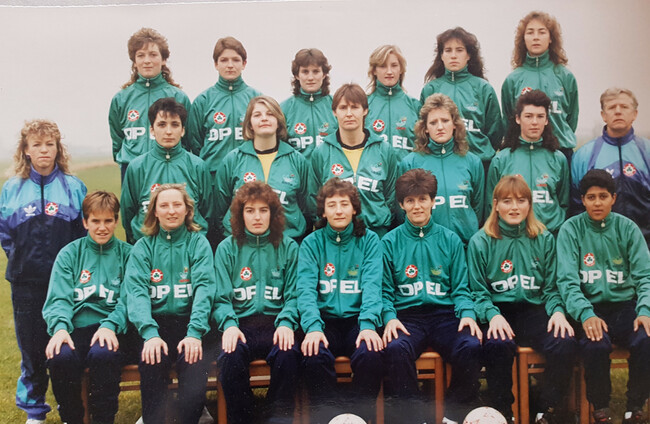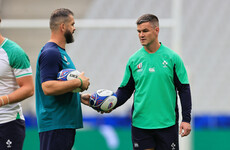ONE OF the unfortunate consequences owing to the lack of attention devoted to women’s sport over the years is that so many records of events have been lost to time.
The athletes too have largely been forgotten, with the exception of sports such as tennis and athletics where female stars have traditionally received a fairer proportion of coverage relative to their male counterparts.
One of the challenges of writing about women’s football, for instance, from a historical perspective, is simply gaining access to relevant details, assuming they even exist.
In an Irish context, the significant rise in coverage of the sport over the past 10 years means future generations of fans will at least be better served in ascertaining information from the present period.
‘Football was not invented in 1992′ is a common complaint in the men’s game, given the media’s tendency to sometimes overlook facts and figures from the pre-Premier League era.
The early 1990s was also a watershed period for women’s football, as the Ladies Football Association of Ireland achieved formal recognition from the Football Association of Ireland.
Women’s football subsequently integrated with the FAI and gradually gained greater support, the lack of which partially explains why information on players of previous generations tends to be quite scarce.
With the internet not widely used at the time and newspaper coverage sparse at best, some pivotal historical figures from the women’s game in this country have tended to get overlooked and ultimately forgotten.
There have been attempts by some to rectify this problem — the Women’s Soccer Archive is an example of an excellent resource that appears as comprehensive as possible in documenting Irish women’s footballers of the past and present.
And one player who certainly does not deserve to be forgotten is Marian Leahy.
Growing up in Garryowen, Limerick during the 1960s and ’70s, Leahy played a variety of sports and would often find herself the only girl playing 7-a-side soccer down in the fields — the area where her mother would always know she could be found come dinner time.
Leahy initially linked up with Limerick Ladies under the tutelage of Frank ‘Junior’ Keane when she was just 15 years old.
As a result of the success she subsequently enjoyed at club level, Leahy was called up to train with the Irish squad.
Despite primarily considering herself an outfield player, Leahy reckons she spent around 40% of her career as a goalkeeper, and Keane encouraged the teenager to tell the Irish management she could play there in order to boost her chances of progression at international level.
“Kevin Healy, Eamonn Darcy and all these guys would have been at these boot camps so they’d be looking at players to represent Ireland,” Leahy tells The42.
“And at that time, it was difficult playing in goal because I don’t know if you remember the old Casey footballs? They were a nightmare to try and kick around. If you saved a ball with that, you felt the pressure on your hands.
“So as a result of that boot camp, I got invited to become part of the Irish squad in 1976. I was an unused sub for the draw against Scotland that year.
“I made my debut in 1978. We played England in St. James’ Park, Exeter. And I wasn’t even supposed to be playing that day.
“I cannot recall what happened, but I ended up playing in goal. And I know it was one of the major things that stood out in my mind because we were beaten 6-1 and when I walked off that field, I actually got a standing ovation from the crowd. The report afterwards said it could have been 10 or 11 had I not played that day and I just seemed to play on my skin.
“So from there, I had an international career on and off over the 20-year period through the various different managers. Some ups and some downs, some gaps in between.”
One of the ‘downs’ in question emanated from a selection dispute: “The Troubles were going on in the north and I was reluctant to go up there that particular time,” she explains. “So they left me out of the squad for a while.”
Leahy eventually was deployed as an outfield player — mostly right-back, but also centre-half, central midfield or right-wing on occasion.
She would sporadically revert to the position of goalkeeper when necessary, however, partially because having an outfield player who could play in nets was cheaper than incorporating an outright stopper in reserve.
“You didn’t actually need to bring a second goalkeeper in the squad,” she recalls. “And they needed to keep the numbers down because they could only afford to bring so many.”
Moreover, particularly in that era, there were numerous obstacles associated with being a female athlete.
“I was working 9-5, at home at six o’clock. And then we’d be training: Monday, Wednesday, Friday, all day Saturday, all day Sunday.
“Then, when you had to take leave, you had to get permission from the place you were working. And that wasn’t always readily given.
“I don’t want to say where I worked because I’d be giving it a bad name, but they didn’t particularly want me to go [on away trips]. And I got injured in Sweden. I went over with a twisted ankle. So I was out of work for a while. And I was getting letters from the job telling me I better come back in if I want to keep my job.
“So it was tough. It was really, really tough. And that’s what you were up against. I had to get my doctor to get onto the job to say that he had signed me off, so it shouldn’t be in question.”
Going on away trips were less than straightforward, not just for individuals trying to get time off, but for the team at large more often than not.
“To be honest, Ireland pulled out of some qualifiers,” she says. “We just couldn’t do it because there were no funds there. That’s why when you look back, I can’t even recollect how many caps I have. Because the first cap I got against England in St James’ Park isn’t even recorded as a cap. I wasn’t even on the card, I wasn’t meant to be.
“It was just [due to] whatever happened that I played. So there was no person keeping a track of the actual number, and back then anyway, most of the games were friendlies, they weren’t competitive. So you played Northern Ireland a lot, you played Scotland or Wales, because they were achievable from a financial perspective.
“But it was very rare that you could get the financial backing to go much to other places. Now, that did change somewhat when [ex-Ireland manager] Fran Rooney came into the equation because he got a lot of sponsorship for us to be able to do things like that.”
She continues: “We still had the situations where we’d be changing in the toilets. And you know, in the airports, we’d be getting the tracksuits and the clothes on and we’d have to be giving them back the day after. And I mean, every game that I captained, the pendant that you were given at the start of the game, I thought that that’s something that I could keep, they were mementoes. But you had to give those back. They were all given back. I don’t even know where they are today because, at that point, [the LFAI weren't] fully associated with the FAI. And so I don’t actually know what happened to those if they’re still there to be seen.”
The conditions that past female players had to endure have been well documented, but they are still remarkable to reflect on in a modern context.
“When I was part of that first squad, when we came to Dublin, we had to have some of the other squad members take us to their homes, and put us up overnight, and feed as well over there,” Leahy remembers.
“That was the only way it could happen. And we were travelling up in trains and being brought up. We stayed out in the girls’ houses in Cabra, they were very, very good to do those kinds of things.
“We were training in the Phoenix Park and Fairview Park, we were just training in open spaces anywhere that we could get a bit of space.
“That’s how things happened. And that went on for a long, long time. I think the first official ground that we trained at that I can recollect was probably the training rounds out in Goatstown. We used to get there for weekends to train as part of Fran Rooney’s group, and it was only then you could start seeing the difference in a little bit of money behind it.
“We had some great results, 1-1 with Holland and stuff like that, but we were miles behind everywhere else. The only thing I can compare it to today is if you think we played Spain as part of Linda Gorman’s group, and we got a good result there.
“And if you look at where Spain are today, they’re just so good. Now, the Irish team today, I have to say, are miles ahead now to where we were back in the day. But they have things behind them now, the girls are playing professionally. So that has helped the national side progress. But back in our day, we had absolutely nothing.”
While it was not until 2017 that a high-profile protest from the Irish squad helped create meaningful change, there was anger and frustration behind the scenes long before then.
“I think some of the girls just stopped being interested in playing because it was costing us money. Why would you want to? I could be spending that on a night out, but instead, I had to spend it on a train up to Dublin. There was no support. There was no backing, there was very, very little input. The FAI wanted nothing to do with it until [the link-up with the LFAI in the early '90s].
“And even then, you may have been associated with them, but you may as well have been a different entity altogether.
“And it was hard when you were getting hammered 4-0 and 5-0. And it wasn’t from lack of training. When I moved to Dublin in ’88, we trained five days out of seven. We were like many professional people in the way we were training. We had a training programme that we had to follow and we did that for the love of the game.”
The results may not have always been positive, but Leahy and her colleagues certainly helped pave the way for the current generation of Irish players and feel their contribution should not be overlooked or underappreciated.
“I do believe that there could have been an effort made on [the FAI's] part to engage some of the ex-internationals involved in their setup.
“You wouldn’t even get a notification that games were on if you didn’t hear about it on the news or the radio or something. I just think that’s a bit sad that you have players that have played for their country for years and years and years and yet, there was no courtesy sent out to say: ‘Look, would you like to join us for the women’s game tonight?’
“There should be a little bit of hindsight on their side, I think they should go back and they should do a little bit to recognise that a team did exist prior to 1993.
“And although they might not have a whole lot of information available, there are some people out there who are able to provide them with that information.
“My address has not changed in 30 years. They should at least send out an invitation with the big games coming up or in the past. It isn’t as though that’s going to cost them a lot of money for them to do something like that. All you’re doing is sending out a letter and you’d be surprised the number of people that might actually respond and attend and then it’d be a nice catch-up.
“And then the current squad could see: ‘Oh, look at all these ex-internationals here, I didn’t know that they even played.’”
Of course, there were plenty of positive memories also — captaining Ireland against England at Wembley and drawing 1-1 against a top Swedish side are two, in particular, that stand out.
Now aged 61, Leahy finished playing in 1998 and while she had a brief foray into coaching, the ex-Ireland international has largely stuck to enjoying other sports, including swimming and racquetball, since retiring.
Of her time as a footballer, Leahy concludes: “It just wasn’t to be, just the era you were in, the place you were working, women’s sport wasn’t recognisable. They weren’t getting the headlines. And even today, the headlines for the ladies in the papers and on the internet are very sparse. It’s taking too long to get where they’re going, but they’re getting there.”

















Fair play Marian. You did yourself, your family and Irish football proud….
Excellent article about a real genuine person., Marian from Garryowen
That is wonderful article thank you for sharing it